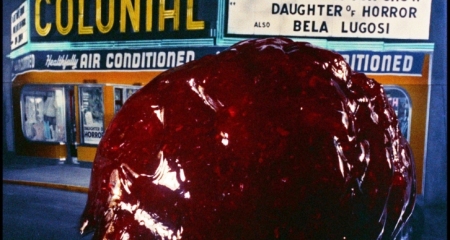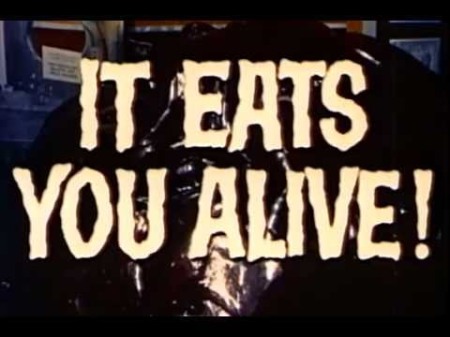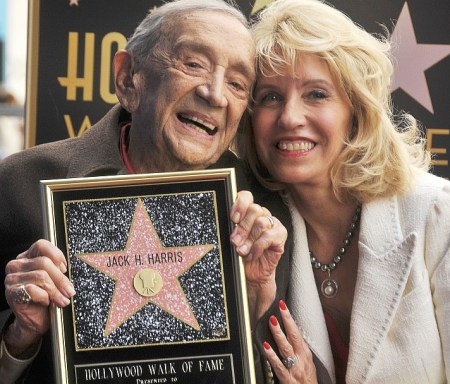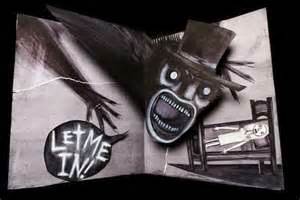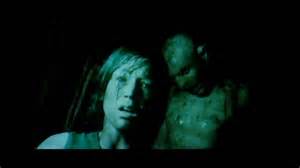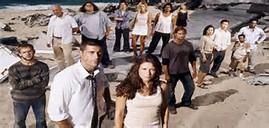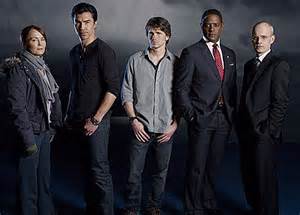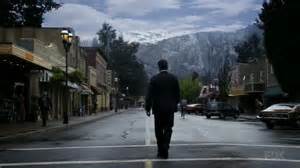
The following story was first published in THE REPENTANT, a 2003 anthology edited by Brian M. Thomsen and Martin H. Greenberg. I send it out to all H. P. Lovecraft fans this Halloween. Boo!
One drives nervously through certain rural country in north central Massachusetts, far from the bustling metropolae of learning and commerce, without even knowing why. The crisp New England air becomes heavy and foetid, even inside an automobile insulated from the elements. The roadside flora offer no solace, for the traveller who might be soothed by the emerald grandeur of lush, verdant hills is instead assaulted by bramble patches and unkempt stands of forest grasping over the motorway, which is bathed in unremitting dusk even as the sun gleams its brightest. When the visitor finally can make out signs of human habitation, they too seem unnerving: broken, pitted wood fences long lain un-repaired; foul rusting yokes upon which large, lean black birds rest at odd angles and stare at passers-by with disquieting intensity; wilting plants of indeterminant genus that push obscenely out of denuded grey land once slit by a plow but thence shunned by its owner.
Nor can the crutches of civilization thrive here for long. When this dank region is spoken of at all, it is chiefly by returning travelers in muffled tones of dread and relief. One finds, they report, that the clammy hand of night can here reach even into the protective cocoon of an auto. No timbre save hissing static may be retrieved from a radio. Tape and disk mechanisms develop curious problems: they are unable to emit the sounds encoded on them and sometimes slow down or speed up unaccountably; various pilgrims have reported slow gutteral resonance not unlike the groaning song of the great leviathans of the deep, while others have heard distressing atonal piping that vaults upward on its alien scale to attain a painful pitch beyond hearing. The unluckiest have experienced mechanical problems, made most ominous by the imminent approach of night-fall, and more than one veteran of the long and lonely byways must suppress a shudder as he recounts the supreme unease with which he stepped out of the car to investigate this or that echoing rattle or metallic sigh.
The portable telephones which have so infested our sophisticated culture are here as useless as one of these Yankee farmers’ abandoned fenceposts — either the land brings its guests too far away from the technological world for communication to reach, or else there is some force, whether climatological or, worse, self-determined, which conspires to isolate this area from the orbit of rational discourse and reason. Looking this way and that, the visitor tends to slink back to the false shelter of the automobile and pledge to deal with the issue later, far away in a warm bed, if only the damned machine will successfully transport him. Never has anyone who has voyaged upon these dark lanes evinced the slightest desire to return.
Those who bravely or naively continue to peer out the window, while they negotiate the curving wooded roads toward blessed home, can usually discern the inhabitants of this forsaken clime. They are a solemn and oddly distanced lot, gazing without expression from well-trodden pasture or from the porches of tiny colonial-style houses which are not quite plumb, misshapen in a way that provokes revulsion instead of empathy, and glistening in a foul chitinous fashion as if constructed from the carapace of a giant insect. Their dwellings are spaced miles apart from each other, and no wonder, for they do not seem to particularly relish the company of humankind. There is no wave toward the passing vehicle, no smile, no acknowledgment. Only heads slowly turning to follow the progress of a car will betray the fact that the native watchers are indeed alive. The motorist wishes to escape their forbidding community no more ardently than the citizens of Dunwich wish to see him gone.
It was in the encroaching gloom of late afternoon that one of them, an ancient dairyman named Abner Brockman, followed the latest vehicle with his vacant and sallow gaze until the sound of its passing gave way to the stillness that always pervaded the stricken countryside at this time of the day. He turned back to his herd, a feeble collection of desultory animals which nosed their way through a dirt-pocked pasture nearly picked clean. The scent of mould and decay was on the air, and Brockman instinctively looked upward apprehensively in the direction of the table-like rock of Sentinel Hill. He was unable to make out the summit in the diminishing light, but he needed no visual confirmation of the barren hillock where no tree, shrub, or blade of grass would ever grow.
The first whippoorwill of evening raised its lonely moan, and Brockman pulled his jacket tight against his neck. These birds frightened and distressed the residents of Dunwich, where local superstition held that whippoorwills were creatures that waited for the souls of the dying, and that their cries are timed to the wretched victim’s last breath. It was still early and the bird was joined by no others, but that did not prevent a shiver from coursing through Brockman’s body as the dull silence descended again.
The metallic clang of a cowbell bit the air as old Sarah, Brockman’s doddering prize Guernsey, padded toward the fence. Something was bothering her. Her tail swatted furiously and she picked up speed. Now the other cows joined in, bleating pathetically and fighting to escape the middle of the field—not in one direction but toward all sides in a stampede from the center. Whatever the disturbance was, it emanated from a bald patch that the half-ton animals were laboring to flee. Brockman moved closer.
Suddenly the ground heaved with a sharp jolt, as if an explosion had been set off beneath. The cattle leaped away with even greater force. As Brockman stared in amazement, a tight plume of dirt sprayed into the air like water from a fountain and left a small hole in the pasture, through which something was struggling to emerge.
A cloven hoof pawed its way out of the hole and was joined by another. The hooves strained to widen the aperture, and a bovine nose appeared, snorting with a prodigious effort. Rooted to the spot, Brockman watched as the fawn-colored head of a full-grown Guernsey pulled into the light. How had the beast fallen into the earth?, he wondered. And how was it possibly attaining the strength to correct its condition? The rest of the herd had run as far away from the bizarre display as pasture fencing would allow, many of them headed in the direction of Sentinel Hill, which it had always before been their nature to shun.
The forward half of the cow was now free, and it used its hooves as leverage against the plane of the pasture. With a moist pop the rear half emerged, and Abner Brockman’s grip on sanity loosed to the point of dissolution. For he was accustomed to the creatures of a natural order; what he now beheld was an atrocity from somewhere past the known laws of biology, beyond the three dimensions which deluded men of science into believing they had any inkling of the soul-shattering mysteries that long predated the emergence of Homo sapiens on the planet.
About halfway down its body, the creature simply failed to be a cow any more. It was covered with matted black fur, through which protruded dozens of wormy grey tentacles, each waving and undulating independently to create a horrible writhing skirt below which no legs protruded. At the end of each tentacle was a reddish sucker, opening and closing with a hideous sodden sound. Where the tail might have been on a normal beast was a longer, thicker trunk or feeler that swayed and pushed against the ground. A greenish-yellow substance with the consistency of syrup oozed from the fur surrounding the tentacles; its mouldy ichor attacked Brockman as surely as if he had been struck by a fist, and he felt the ache of nausea rise in his belly as the rank odor hung heavily on the still air.
As Brockman watched in stupefaction, sets of eyeballs asserted themselves among the fur and disappeared, only to re-emerge at another spot. They were constantly winking into existence and receding, all over the creature’s rear section. Then a slit appeared in the midsection and opened slightly to reveal a set of canine teeth, above which a larger set of reddened eyes appeared and set, then a nose. The dark fur over the obscene countenance lightened while Brockman watched and resolved into a half face, elongating impossibly along the side of the beast until it was better than a yard wide, an impossible imitation of the human form. It was still barely recognizable as the cruelly distorted face of a young man, topped by crinkly albino hair, whose eyes were now jutting wide with exertion as it attempted to speak.
The mouth moved slowly and a deep bass rumble issued forth from it, a noise that at first sounded like an animal growl. But as the cavity opened and closed, a ghastly green tongue occasionally protruded to help produce a variety of humming, clicking and sibilant sounds, and somehow Brockman understood that there was an intelligence operating this blasphemy. The cow’s head that remained on the damned pseudo-beast raised its snout skyward, and matched the unearthly noises coming from its torso. In unison, the twin vocal boxes spewed what sounded at first like gibberish, but then resolved into strange croaking words:
“Ygnaiih…N’gai…Y’bthnk…Bugg-shoggog…my mother…YOG-SOTHOTH!”
That was enough for Abner Brockman. He fell to his knees, blubbering nonsensically, drool rolling out of the sides of his mouth, then pitched forward into a cowpie. His hair follicles were already beginning to lose their color, and his reason was forever lost with them as the abomination moved wetly toward him.
◊
F’tagn Whateley slithered closer to the fallen man and his extensions drooped in frustration. He had tried everything he could think of to make a connection. He had taken on the frame of the creatures with which this human had surrounded himself. He had made the vibrations of welcome, had even used the human tongue—and eyes! F’tagn could smell success as the man watched and tried to comprehend, and he had undulated with excitement. But it was always the same. Was he so horrible? His life surely was. Some Great Old One he was making.
F’tagn couldn’t help that he was a halfbreed. It wasn’t his fault that mapped upon his handsome glutinous frame was part of a human face, elongated in a fetching way to be sure, but still there. He was a twin, born several human generations ago of Old One and earthly woman in an arcane ritual atop Sentinel Hill that was supposed to seal the eventual fate of humankind. But that still made F’tagn a pup in the multifaceted eyes of the rest of his dad’s crew. He hadn’t even been around for one single aeon. And it was so hard to fit in. Most of the other Old Ones turned their tentacles away whenever F’tagn oozed by, repulsed by the human half of him. They could sense it, smell it. After all, the rest of them were from some grand unnamable place beyond angled space. F’tagn was from Massachusetts.
Eternal life was so unfair.
Pop could have thought of this before he had congress with old albino Lavinia Whateley that randy night so long ago. In the phrase of the daemons of Nyarlathotep, what possessed him? Several of the night-gaunts that hung around the great stone city of R’lyeh, now sunken in the ocean, would chitter conspiratorially at the sight of F’tagn, and it was plain that his Great Old Man had done a bit of bragging at some point. Everybody was curious about the physical details: how’d you do it, stud? A couple of shoggoths had gone out and experimented with farm animals in the vast Midwestern regions, but when the smoke cleared, all that was left were mutilated cows and frustrated shoggoths.
But however he’d managed it, F’tagn was living proof that Pop was a sexual pioneer. F’tagn and his twin brother Wilbur. The lucky bastard—actually, they were both bastards—Wilbur had favored their mother. He could pass for human in Dunwich, and he grew up among people. They may have distrusted him, even feared him, because Whateleys tended to keep to themselves, and that kind of behavior attracts gossip, especially in New England.
But at least Wilbur got to be out there in the world. In contrast, F’tagn had been boarded up in the second story of his grandpa’s house for most of the time he was a Young One. That experience would create psychological problems in most any kid, but F’tagn had inherited something that nobody had expected, certainly not his dad. He had been conceived as a leader of the new generation. But F’tagn was proud of his human side, and he yearned to communicate with his half-kind.
It didn’t help that Wilbur had seemed as intent on bringing forth the reign of the Great Old Ones as fervently as any shambler from the stars. Wonderful. He gets the gene of human appearance, and what does he do with it? He devotes his life to the destruction of the world order and the domination of conquerors from the depths of time and space. Not to mention the fact that Wilbur hadn’t bothered to hide his disdain for their mother, insane and decrepit though she might have been. Toward the end, before Wilbur overstepped his bounds and got his just deserts, she had even grown afraid of him. F’tagn felt for her. But every time he tried to reach out like a good son, his mom would run screaming from the house.
Like most humans who were zealous enough or nuts enough to look into the apocalypse issue, Wilbur had gotten a lot of it wrong. The drill was that great Cthulhu, the Oldest of Old Ones, was dreaming in the ocean, in his house in the sunken R’lyeh, waiting for some clever folks to unearth certain forbidden books and spit out just the right incantations. That would open the cosmic gates and bring back the original rulers of the planet, the Great Old Ones. The entire posse would come roaring in to devastate the world and, of course, tear out the humans—including the incantors, which would make necromancy a pretty self-limiting career path.
Of course, this was all horseshit.
To call the Old Ones back, no mumbo-jumbo was needed. They had never left in the first place. Insanity and nightmare were their calling cards the world over, and they’d developed plenty of insidious ways to mess with human beings. And Cthulhu could pop in whenever he wanted, thank you very much. He was dreaming in R’lyeh, sure, but that was only because he was exhausted. In this aeon alone, he’d worked on the Black Plague, about three dozen major wars and the Holocaust—and those little numbers had happened without Wilbur’s or anyone else’s help. Why eradicate the human race when it was much more fun to play with them, to instill terror and suffering that would really last? The Old Ones learned their lesson when they snuffed out the dinosaurs. So dumb. The old-timers told F’tagn that it had been very, very boring for several aeons afterward.
But that didn’t prevent people like Wilbur from finding the old dusty tomes and trying to make sense of the ornate gobbledygook inside. The trouble was, these books only had small pieces of the picture, and more often than not, completely distorted ones. The one they called the Necronomicon in particular was fairly fashionable among the hooded-robe set, but it would embarrass them like crazy if they ever got a faithful translation. Like somebody just starting to learn a foreign language, these weekend wizards would say the most hilarious things. You wanted to finish their sentences for them and put them out of their misery. Wilbur himself spent more than one night up at the old stone altar on Sentinel Hill making this ludicrous pained face, clamping his hands to his temples like an idiot and screaming “YOG-SOTHOTH!” Which to Old Ones simply means, “How ya doing?” or, to a tentacled creature like himself, “How’re they hanging?” F’tagn had slipped into his native tongue when he was talking to the man lying before him; he realized he should have continued speaking in human, but the concentrated effort it required had just been too great.
This obsession of F’tagn’s with human connection, which most of the Old Ones considered a debilitating fetish, meant that he had few friends. He didn’t consider it a big loss: they lived in a dimension of their own, oddly shaped angles and all. These fuddy-duddies were so non-Euclidian! But he did get out socially. For example, there was the monster who had become close to a Boston painter named Richard Upton Pickman, even posed for him in his gallery. That was fascinating. F’tagn hung around him for a while, peppered him with questions about the relationship, but it became clear that there had been no real communication, that he was dealing with a beast who just enjoyed seeing himself in pictures. It was a matter of ego, not empathy. Plus there was the upsetting fact that the model had been rendered while in the process of devouring a human being. No matter how many times he heard somebody say that they were just animals, F’tagn could never develop a taste for human flesh.
In general, F’tagn was shunned and mocked as a disappointment to his father, whom he hadn’t seen in decades. No doubt Pop was out haunting some other poor lonely hamlet, making a hundred eyes at another disturbed human waif. He had a swaggering new reputation to uphold, after all. But F’tagn got the definite idea that Pop had wanted to use his cross-dimensional ardor to improve his own standing, to suck up to Cthulhu. It would be the ultimate desecration, creating a new race of conquerors from the very wombs of their prey. And starting off with twins, to boot! But the splitting of the seed from beyond had unexpected effects—as perhaps might have been expected if anyone had bothered to reflect on it in the first place. Wilbur got the looks. F’tagn got the heart. And the Whateleys would go down in history as the single most dysfunctional family on earth—or under it.
F’tagn was the first of a new line of Old Ones. Just not the kind Pop had wanted.
F’tagn was so sorry. Sorry that his own kind made dinner out of people. That his very countenance was enough to cause a simple farmer to go mad. That Old Ones carried such dimensionist bigotry along with them every century of their lives. The world was a big place—big enough so that one day, just maybe, if they tried very hard, two species might walk hand in feeler, together at last in peace and harmony. Well, any change begins with a single act. And F’tagn Whateley was going to be the being who got the ball rolling.
A sharp clap of thunder disturbed F’tagn’s reverie and he looked down at the wretched dairyman before him. Thankfully, he had lost consciousness. It was tough to make out his features in the deepening gloom. F’tagn brushed his face gently with a tentacle, an action that would probably have returned Abner Brockman to sleep had he witnessed it. The silence that had ruled the late afternoon gave way to the excited cries of a flock of whippoorwills, and F’tagn looked up to the sky. The hellish birds had massed above the barren Devil’s Hop Yard on the ridge, circling in frenzy. Then, on an invisible signal, they poured down the hill toward Dunwich.
F’tagn knew what that meant. They were trolling for the souls of those who were about to die.
Old Ones must be gathering, he realized, for a night of carnage.
He shambled down the hill as quickly as he could move and headed for the town square.
One of the many advantages Old Ones had over humans was that they could move among them unnoticed, walking as they will between the dimensional spaces. You could never fool an animal, not even one as dumb and sweet as a cow, and more than one victim-to-be had made the mistake of ignoring a barking dog or hissing cat which sensed the mind-shattering presence of an Other. Besides, the way most of F’tagn’s cousins looked, it would be impossible to sneak in anywhere without the protective coat of invisibility. He doubted that even Pop could have scored the way he did without sparing his paramour the family’s good looks. So most OOs began their fun with auditory and olfactory components. They’d bang on walls and doors, and leave their spoor in the middle of a room—it didn’t take long for it to develop a smell of decay so acute that it could fell a starving hyena. Another popular gag was to leave tentacular tracks in the dirt or snow and watch some superstitious outdoorsman babble with fear as he tried to explain. F’tagn didn’t approve, but this was all fairly harmless stuff.
But Old Ones couldn’t hide from each other. And when he arrived in town, F’tagn saw immediately why Dunwich had attracted so many whippoorwills. Though the locals may not have realized it yet, their fair township had just become host to a veritable Double-O convention. For some reason, lots and lots of things were here.
The square was a riot of slithering, crawling, scuttling, shambling beings of every description imaginable, and some that probably weren’t. The fishboys from Innsmouth were here, the pyramid people from frozen Antarctica, the three-lobed burning eye, the goat with a thousand young, the jelly things, the fungous orbs from Vermont, the shining trapezohedron creatures, the blasphemous bee buzzers, the haunters of the Monolith, and many more. Even Pickman’s model had bestirred itself to wander up from Boston for the occasion.
Of course. The occasion. All became clear.
Hallowmass.
It was the closest thing to a holy moment—had they dared to describe it as such—on the Old Ones’ eternal calendar, the night when, as one, they reaffirmed their dominion over their weak, timid enemies in a gruesome orgy of gluttony and debauchery. They always fasted before the big day to make sure they were supremely hungry. F’tagn had once described the celebration to a scale-crusted frog-man as “the spring break from hell,” but there was no response from the humorless batrachian.
This year, for Hallowmass, they had selected F’tagn’s home town, right under his nose. Why did it not surprise him that he hadn’t been invited?
The ghastly conveneers massed against a tiny schoolhouse, its windows warm with golden firelight. Judging from the agitation of the whippoorwills, now piping as loudly as they could, there were quite a few people inside—no doubt terrified by the cacophony of noises outside and a nose-burning aroma beyond description, so pungent that it threatened to beat down the door all by itself. F’tagn could hear wails through the walls, and was dismayed to make out the cries of children among them.
The front flank moved toward the door, as much in unison as their varying methods of locomotion would allow. F’tagn knew what would follow. The famished mob would take corporeal form and visit an unspeakable fate upon those inside—keeping them alive as long as they possibly could. Dunwich would become an abattoir, and augment its reputation as a haunted, doomed spot for years to come.
F’tagn screwed together his courage and slithered past the leading edge, his back to the door. The creatures halted, puzzled. Most of them had never met F’tagn before, and their antennae, feelers and eyestalks sent them mixed signals. The stench of human was definitely upon this one, but he looked as much like an Old One as did the most horrific of the Hallowmass revelers.
Panting with hunger and anticipation, a monkey-crab feinted toward F’tagn with his pincers and scampered back, but he held fast. The crowd moved inexorably closer, and F’tagn readied his most threatening infra-bass roar. He had no chance against so many, but maybe they would think twice about harming one of their own. If that was in fact how they regarded him.
Three pink, gelatinous rats, each the size of a large cat, ran in to attack. F’tagn let loose his howl and swiped at them with a tentacle, and they leaped back toward the crowd. But it was already so close that there was no room to retreat. As the front rank recoiled from F’tagn’s aria of aggression, they were pitched over by the body mass pressing in, and the rats took the full weight. Tiny bones cracked and the hellish rodents squealed in mortal pain. But what really turned the tide was the delicious iron smell of blood.
This was too much for the carnivores in the mob, which was just about everybody. Those closest to the rats literally fell on them and began dining, but they had to compete with a host of maddened rivals made delirious by the scent. One scratching, slicing fight led to another, and soon interdimensional blood was flowing all over the square as the Hallowmass convention proceeded to devour itself. It was the most horrible sight F’tagn had ever seen.
Upstairs, the whippoorwills had no idea what to do. Prepared to capture human souls from the schoolhouse, they were thrown into pandemonium. Without direction or purpose, they flew around at random, keening their annoying piping sounds and smashing into each other at full speed—only to become main courses themselves as they descended upon the grasping mob.
Within a few minutes, the crowd had lessened by more than half, and it was evident where the excess had gone. Happy, finally sated Old Ones exchanged pleasantries, made signs of mutual respect in the limited number of physical ways that they could manage, and promised to meet again next year. Only a few malcontents–like Pickman’s model, who had, not unexpectedly, survived–complained about the lack of human on the menu; many more raved over the exciting, unexpected way that the meal had been served. It was clear that this event would be one of those legendary stories told to jealous Old Ones who had had the misfortune to be elsewhere, for aeons to come.
F’tagn leaned back against the door, inside which the schoolroom had gone completely silent, what with the piping and clawing and chewing. Maybe he hadn’t communicated with his human half-kind. But he had saved them from a fate they would be better off not knowing about. F’tagn was happy. He’d started something between Old Ones and humans. Maybe even gone a small way toward affecting the Old One diet! He was just starting to plan what to do next, when. . .
. . .F’tagn Whateley disappeared from the spot, and from Dunwich, forever.
◊
A long time must have passed, for F’tagn was groggy when he awoke in a great city of granite and marble, of monoliths and sepulchers. And water. Lots of water in this city. There was only one place it could be.
R’lyeh. Cthulhu’s undersea crib.
F’tagn started to get up, but his human-face torso was chained to a stone tablet and each tentacle was restrained. He had to shut all his eyes when he pulled against the chain.
The Hallowmass episode had gotten back to the boss somehow. How could it not? He sighed. Pop’s experiment with earthly union had produced a mutant. And evidently it hadn’t amused the big guy—F’tagn was responsible for too many dead and digested Old Ones. Not to mention disturbing a long Cthulhuian dream.
The leader had spoken. He’d pulled the plug. F’tagn was out of commission.
Well, so be it. Maybe R’lyeh was the right place for him now. Maybe he might even get to meet the great thing. Maybe talk to him. Maybe the next time Cthulhu woke up and rubbed his many eyes, they could reason together. Plan a new future for the dimension that gave F’tagn birth.
After all, stranger things had happened. Way, way stranger.
And besides, F’tagn had aeons to think about it.

“The Recall of Cthulhu” Copyright © 2003 by Tom Dupree.
All rights reserved. Reprinted by permission.
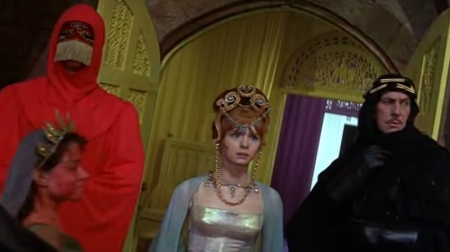
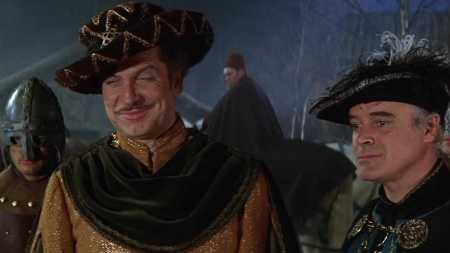
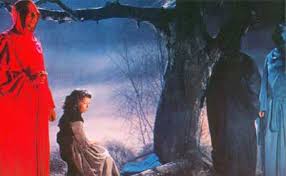
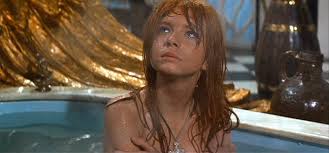
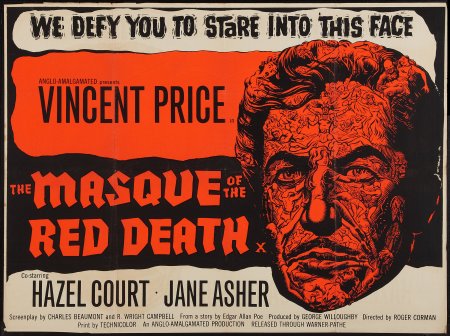



 Posted by Tom Dupree
Posted by Tom Dupree 
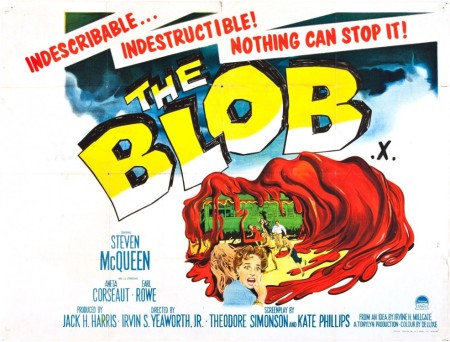 It was the age of exploitation in the movie business as the industry frantically swatted away against the incursion of television on its customers’ leisure time: movies needed to be — or at least seem to be — bigger, bolder, better. Plus, by the late Fifties the recently christened “teenager” had developed into its own lucrative category for marketers. As another contemporary showman put it, these kids loved cars, girls and ghouls. So movie after movie gave it to them. And towering over them all was a big ball of malevolent jelly, the frickin Blob.
It was the age of exploitation in the movie business as the industry frantically swatted away against the incursion of television on its customers’ leisure time: movies needed to be — or at least seem to be — bigger, bolder, better. Plus, by the late Fifties the recently christened “teenager” had developed into its own lucrative category for marketers. As another contemporary showman put it, these kids loved cars, girls and ghouls. So movie after movie gave it to them. And towering over them all was a big ball of malevolent jelly, the frickin Blob.